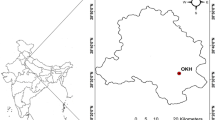Abstract
In this work, we have measured the surface photovoltage of airborne particulate matter of size up to 10 microns (PM10) through scanning Kelvin probe (SKP) system at room temperature. The aerosol samples were collected using a dust respirable PM10 sampler located in SRM IST campus (12.81° N and 80.03° E) during September-2018 (Sep-2018) and November-2018 (Nov-2018). The morphology of the collected aerosol was characterized through HR-SEM. The chemical composition of the aerosol was confirmed by energy dispersive X-ray (EDX) analysis. The EDX results confirmed the presence of more oxygen and absence of carbon content in the aerosol collected during Nov-2018. The vibration modes of identified chemical compositions were confirmed by Raman spectrum. Finally, the contact potential difference of both samples was measured by SKP with respect to visible light exposure. Interestingly, aerosol collected during Nov-2018 have better visible light response compared with Sep-2018 sample. This is probably due to the possibility of metal oxides formation without carbon contamination during Nov-2018. Meteorologically inferring that these pollutants have been transported from the Arabian Sea and continental India in most of the days during September- and November-2018, respectively. These results pave the way to use the metal oxides rich aerosol collected for particular month can be utilized toward optoelectronic and gas sensor applications.







Similar content being viewed by others
References
K. Aruna, T.V. Lakshmi Kumar, B.V. Krishna Murthy, S.S. Babu, M.V. Ratnam, D.N. Rao, Short wave aerosol radiative forcing estimates over a semi urban coastal environment in south-east India and validation with surface flux measurements. Atmos. Environ. 125, 418–428 (2016). https://doi.org/10.1016/j.atmosenv.2015.08.085
G. Purnadurga, T.V. Lakshmi Kumar, K. Koteswara Rao, M. Rajasekhar, M.S. Narayanan, Investigation of temperature changes over India in association with meteorological parameters in a warming climate. Int. J. Climatol. 38, 867–877 (2018). https://doi.org/10.1002/joc.5216
T.F. Stocker et al., IPCC-2013: climate change 2013: the physical science basis. Contribution of working group I to the fifth assessment report of the intergovernmental panel on climate change, 1535. (2013). https://doi.org/10.1017/CBO9781107415324
V. Ramanathan, P.J. Crutzen, J.T. Kiehl, D. Rosenfeld, Atmosphere: aerosols, climate, and the hydrological cycle. Science 294, 2119–2124 (2001). https://doi.org/10.1126/science.1064034
R. Agnihotri, T.K. Mandal, S.G. Karapurkar, M. Naja, R. Gadi, Y.N. Ahammmed, A. Kumar, T. Saud, M. Saxena, Stable carbon and nitrogen isotopic composition of bulk aerosols over India and northern Indian Ocean. Atmos. Environ. 45, 2828–2835 (2011). https://doi.org/10.1016/j.atmosenv.2011.03.003
T. Novakov, M.O. Andreae, R. Gabriel, T.W. Kirchstetter, O.L. Mayol-Bracero, V. Ramanathan, Origin of carbonaceous aerosols over the tropical Indian Ocean: biomass burning or fossil fuels? Geophys. Res. Lett. 27, 4061–4064 (2000). https://doi.org/10.1029/2000GL011759
K. Aruna, T.V.L. Kumar, D.N. Rao, B.V.K. Murthy, S.S. Babu, K.K. Moorthy, Black carbon aerosols in a tropical semi-urban coastal environment: effects of boundary layer dynamics and long range transport. J. Atmos. Sol. Terr. Phys. 104, 116–125 (2013). https://doi.org/10.1016/j.jastp.2013.08.020
C.A. Pope, D.W. Dockery, Health effects of fine particulate air pollution: lines that connect. J. Air Waste Manag. Assoc. 56, 709–742 (2006). https://doi.org/10.1080/10473289.2006.10464485
K. Aruna, T.V. Lakshmi Kumar, D.N. Rao, B.V. Krishna Murthy, S.S. Babu, K. Krishnamoorthy, Scattering and absorption characteristics of atmospheric aerosols over a semi-urban coastal environment. J. Atmos. Sol. Terr. Phys. 119, 211–222 (2014). https://doi.org/10.1016/j.jastp.2014.08.009
D.C. Doughty, S.C. Hill, Automated aerosol Raman spectrometer for semi-continuous sampling of atmospheric aerosol. J. Quant. Spectrosc. Radiat. Transf. 188, 103–117 (2017). https://doi.org/10.1016/j.jqsrt.2016.06.042
A.P. Ault, D. Zhao, C.J. Ebben, M.J. Tauber, F.M. Geiger, K.A. Prather, V.H. Grassian, Raman microspectroscopy and vibrational sum frequency generation spectroscopy as probes of the bulk and surface compositions of size-resolved sea spray aerosol particles. Phys. Chem. Chem. Phys. 15, 6206–6214 (2013). https://doi.org/10.1039/c3cp43899f
D. Chidambaram, G. Vattikondala, G. Marappan, Y. Sivalingam, Indium content dependent VOCs interactions in monolithic InGaN/GaN multi quantum well structures grown by MOCVD. Mater. Sci. Semicond. Process. 104, 104694 (2019). https://doi.org/10.1016/j.mssp.2019.104694
D. Davis, G. Marappan, Y. Sivalingam, B.B. Panigrahi, S. Singh, Tribological behavior of NiMoAl-based self-lubricating composites. ACS Omega 5, 14669–14678 (2020). https://doi.org/10.1021/acsomega.0c01409
G.K. Dutta, S. Kasthuri, G. Marappan, S.V. Jayaraman, Y. Sivalingam, C. Di Natale, V. Nutalapati, Aggregation behavior in naphthalene-appended diketopyrrolopyrrole derivatives and its gas adsorption impact on surface potential. J. Mater. Chem. C 7, 9954–9965 (2019). https://doi.org/10.1039/c9tc02226k
M. Elakia, M. Gobinath, Y. Sivalingam, E. Palani, S. Ghosh, V. Nutalapati, V.J. Surya, Investigation on visible light assisted gas sensing ability of multi-walled carbon nanotubes coated with pyrene based organic molecules. Physica E 124, 114232 (2020). https://doi.org/10.1016/j.physe.2020.114232
K. Guruprasad, G. Marappan, S. Elangovan, S. Velappa Jayaraman, K. Kamala Bharathi, G. Venugopal, C. Di Natale, Y. Sivalingam, Electrical transport properties and impedance analysis of Au/ZnO nanorods/ITO heterojunction device. Nano Express 1, 030020 (2020). https://doi.org/10.1088/2632-959x/abc6f8
G. Marappan, K. Pushparaj, Y. Sivalingam, V. Nutalapati, V.J. Surya, Naphthalene appended diketopyrrolopyrrole derivatives functionalized on ZnO nanostructures: an investigation on gas adsorption induced surface potential changes at room temperature. Mater. Lett. 304, 130724 (2021). https://doi.org/10.1016/j.matlet.2021.130724
M.A. Williams, T.V.L. Kumar, D.N. Rao, Characterizing black carbon aerosols in relation to atmospheric boundary layer height during wet removal processes over a semi urban location. J. Atmos. Sol. Terr. Phys. 182, 165–176 (2018). https://doi.org/10.1016/j.jastp.2018.11.018
A. Singh, M. Kumar Thakur, P. Geesupalli, N. Rajesh Anandan, L. Kumar, S. Sharma, P. Kumar, Scaling of heavy rainy days with upper air profiles over Chennai during northeast monsoon. Indian J. Radio Space Phys. 49, 153–161 (2020)
Acknowledgements
Y.S. thanks the Department of Science and Technology (DST)—Science and Engineering Research Board (SERB), Government of India for financial support (ECR/2017/001218).
Author information
Authors and Affiliations
Corresponding authors
Additional information
Publisher's Note
Springer Nature remains neutral with regard to jurisdictional claims in published maps and institutional affiliations.
Rights and permissions
About this article
Cite this article
Marappan, G., Reji, R.P., Mohan, V. et al. Surface photovoltage measurement of PM10 atmospheric aerosols collected over SRMIST-Kattankulathur campus (12.81° N & 80.03° E): a step towards utilization of atmospheric aerosols in optoelectronic applications. J Mater Sci: Mater Electron 33, 9590–9598 (2022). https://doi.org/10.1007/s10854-021-07582-y
Received:
Accepted:
Published:
Issue Date:
DOI: https://doi.org/10.1007/s10854-021-07582-y




